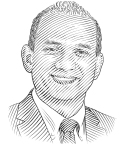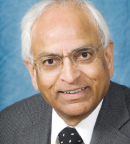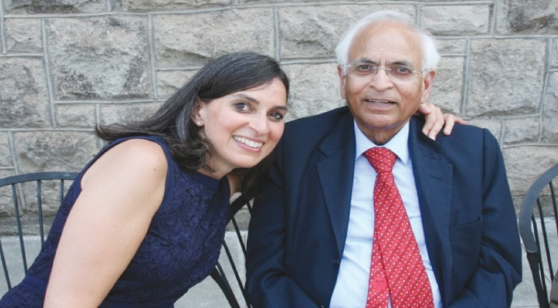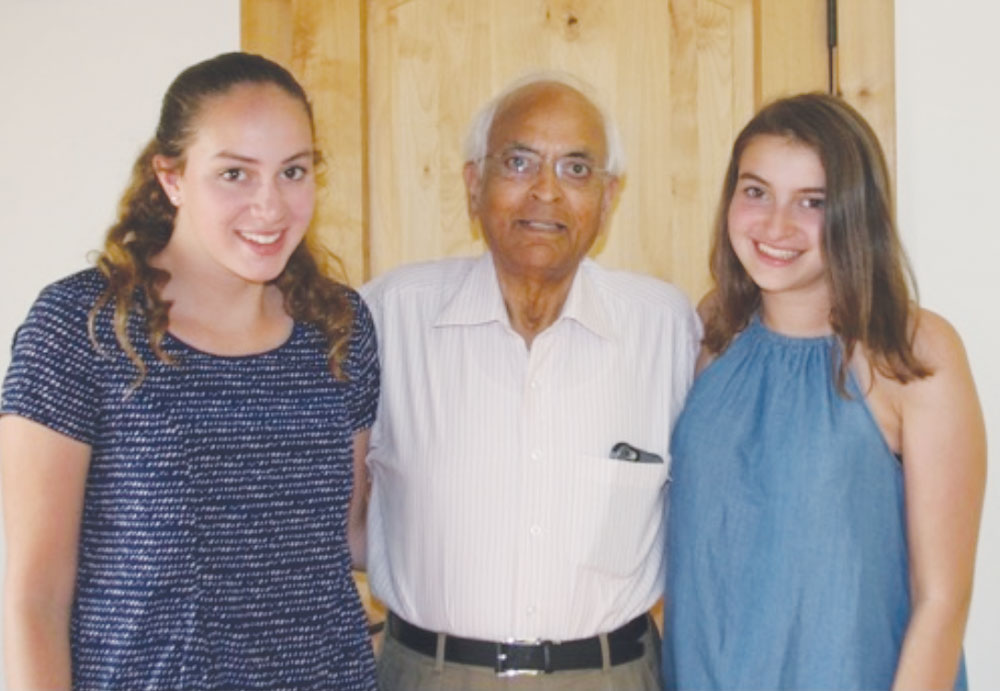Guest Editor

Jame Abraham, MD, FACP
Dr. Abraham is the Director of the Breast Oncology Program at Taussig Cancer Institute, and Professor of Medicine, Lerner College of Medicine, Cleveland Clinic. Find him on Twitter @jamecancerdoc.
For this installment of the Living a Full Life series, guest editor, Jame Abraham, MD, interviewed Kanti R. Rai, MD, Professor of Medicine at the Karches Center for Oncology Research, Feinstein Institute for Medical Research, Manhasset; Professor of Medicine at Zucker School of Medicine at Hofstra/Northwell, Hempstead, New York.
Dr. Rai was born in 1932 in the sunbaked town of Jodhpur, India, during the years when British colonial rule was finally slipping away. “We lived together, two families under one roof. My parents had eight children; my uncle and aunt had seven. But even my uncle’s children called my parents father and mother. It was a joint family, but with only one patriarch and one matriarch—my parents. We all abided by that rule,” Dr. Rai said, adding, “I came from a middle-class family, and my parents did everything they could to ensure that all 15 of us received a good education.”
Dr. Abraham asked what inspired his desire to become a hematologist. Dr. Rai replied, “Hematology wasn’t in the picture; it wasn’t even a recognized specialty in the 1940s. My goal was to become a pediatrician serving needy communities in rural India. My uncle was a doctor, and when I was about 8 years old, I traveled with him on house calls. That is when I saw him caring for malnourished babies and people with severe infections. I was fascinated by his humanity. He treated the wealthy and the poor with the same degree of professionalism and compassion, as if each patient were the only person in the world that needed his care. He inspired my dream of becoming a doctor.”
Road to the United States
Dr. Rai began his medical career in 1955, after earning his Bachelor of Medicine and Bachelor of Surgery degrees from the University of Rajputana. Following medical school, Dr. Rai completed his internship in India at Sawai Man Singh Medical College. “At that time in India, the overriding tendency of young medical school graduates was to go to England for further education and training. I had no desire to go to England; instead, I was drawn to America.”
KANTI R. RAI, MD

Affiliations: Karches Center for Oncology Research, Feinstein Institute for Medical Research; Zucker School of Medicine at Hofstra/Northwell
On an early career move: “I went from treating kids of blue-collar working class families to those who drove Mercedes-Benzes. But people are people, and there is no class distinction in the reality of sick children and worried parents.”
On publication of the Rai staging system: “The editors’ rejection review came back filled with critical remarks about the statistics and retrospective data.… The paper was later published, and the Rai staging system became part of the medical literature. But more important, it changed the way clinicians approached the management of CLL.”
Advice for young hematologists: “I consider myself an ordinary doctor. The only advice I have is to follow your passion, and it always takes you in the right direction.”
Dr. Rai pointed out that during the 1950s, there were not enough medical school graduates to fill the residency vacancies in the United States. To address the shortfall, a representative three-body medical commission went to various foreign nations to interview prospective candidates for internship and residency programs in American hospitals.
“In 1956, I applied for an internship in America,” Dr. Rai said. “A few months later, I traveled to New Delhi for an interview with the American medical commission, which was held at the Indian Medical Association building. We were interviewed one at a time. Hopes were high, and it was nerve-wracking. In the end, only 15 of us out of more than 100 candidates were granted internship positions in America.”
Attracted by a Famous Name
Directly after being selected, the young doctor was subjected to more pressure. “The head of the commission said that I had to choose the hospital I wanted to join in America. At that time, all I knew about America was Times Square and neon lights! They gave me a two-page list of hospitals and told me to choose one that had not been taken yet. I wanted to go to New York, but I didn’t know one hospital from another. The name that jumped out was Lincoln Hospital. After Mahatma Gandhi, -Abraham Lincoln was the person I most admired. So I said, that’s it, Lincoln Hospital. A few months later, I received my contract to serve in Lincoln’s pediatric department. On July 1, 1957, I began my pediatric residency at Lincoln Hospital,” Dr. Rai said.

Dr. Rai and daughter Samantha
Dr. Rai noted that when he signed the contract, he assumed Lincoln Hospital was in Manhattan, not in the South Bronx, one of the inner city’s poorest areas. “The population was largely struggling blue-collar African Americans and Hispanic families. I am eternally grateful for that opportunity because if I had not landed in the South Bronx, my entire education and career would have been totally different, probably not nearly as rich. I developed many close relationships with parents of my patients,” Dr. Rai said.
Trial by Fire
During their conversation, Dr. Abraham asked Dr. Rai if he felt a sense of otherness in being a young doctor from India, an exotic place across the globe. Dr. Rai responded, “Not at all. My resident colleagues came from the Philippines, China, Japan, India, Pakistan, and other far-flung countries. We were united by our core mission of learning to become a better doctor while delivering the best possible patient care, and to this day, I cherish that mission.”
I was a young doctor in an extremely busy hospital, and it was exciting and very sobering to have sick children’s lives in my hands.— Kanti R. Rai, MD
Tweet this quote
He continued, “My attending only came onto the wards a couple of times a day, and so we were basically on our own. I stayed up many nights in the library studying the literature for answers to problems I encountered on the pediatric ward. I was a young doctor in an extremely busy hospital, and it was exciting and very sobering to have sick children’s lives in my hands. It was an incredibly challenging and rewarding introduction to pediatrics.”
15 Miles Away, but a World Apart
After an intensive year at Lincoln Hospital, Dr. Rai realized that experiencing another institution during his 2-year residency program would help nurture his career path. “There was an ad in a pediatric journal for a residency position at North Shore Hospital in Manhasset. I applied, and during my interview, the Chair of the Pediatric Department said that the Chief Resident had gone off to the Korean War, so I became the new Chief Resident. That was in July 1958.”
Manhasset is a leafy, wealthy suburb located on Long Island’s so-called Gold Coast. “It was the polar opposite environment from the South Bronx. I went from treating kids of blue-collar working class families to those who drove Mercedes-Benzes. But people are people, and there is no class distinction in the reality of sick children and worried parents,” Dr. Rai stressed.
A Sick Girl Named Lori
Dr. Rai recalled one day in 1958 when he received word that a child was being admitted who might have acute leukemia, so he waited on the ward for the patient’s arrival.
“She was a 3-year-old girl named Lori, and she arrived with her parents, who weren’t much older than me. Understandably, they were very nervous. Lori had been seen by a hematologist who had diagnosed her with acute lymphoblastic leukemia. I became deeply involved with this child’s care,” Dr. Rai said.

Dr. Rai and son Josh
“My attending, Arthur Sawitsky, MD, showed me how to do a bone marrow aspiration on Lori, reading the slides and teaching me step-by-step,” he continued. “When I asked about her prognosis, he said she would be dead within 6 to 12 months. Lori was discharged several days later. She would be readmitted a few more times, all under my care. She died 8 months later, on my watch.”
Seeing Dr. Rai’s passion while caring for Lori, Dr. Sawitsky urged the young doctor to finish his residency and do a fellowship in hematology at Long Island Jewish Hospital. “I followed that sage advice, and that is how I became a hematologist. Dr. Sawitsky became not only a valued mentor and teacher, but also a great friend,” Dr. Rai said.
Research Opportunity
After finishing his hematology fellowship, Dr. Rai intended to return to India to fulfill a commitment he’d made to himself; however, Dr. Sawitsky convinced him to first get some research experience. He applied and was accepted for a prestigious research opportunity at Brookhaven National Laboratory on Long Island in 1960.
“Brookhaven is where my research interests accelerated and also where happenstance propelled my career,” he said. “The lab’s senior scientist, Eugene Cronkite, MD, was a brilliant hematologist who took me under his wing. Like Dr. Sawitsky, Dr. Cronkite also was a great teacher and mentor.”
My family provides all the balance I need.— Kanti R. Rai, MD
Tweet this quote
After 2 years at Brookhaven, Dr. Rai returned to India, determined to remain focused on research that would help his homeland. However, Dr. Rai’s research initiatives never gained the necessary support and enthusiasm he yearned for, so after 4 frustrating years, he reached out to his mentor, Dr. Cronkite, who happily invited him back to Brookhaven.
When Dr. Rai returned to Brookhaven, he immediately resumed leukemia research, conducting afternoon clinics. “In one eventful day, I saw three patients with chronic lymphocytic leukemia (CLL). One was coming every week for transfusions because of severe anemia, one was coming only once a year, and the other was coming twice a year. It struck me that three patients with the exact same diagnosis had such extremely different presentations. I asked Dr. Cronkite about this clinical conundrum, and he said, ‘that’s just the way CLL behaves—and it was up to me to figure out why.’ ”
Rai Staging System
With that cryptic inspiration, Dr. Rai decided to go full speed ahead with studying CLL. “I had no idea where to start, so I began taking charts of CLL patients out from our medical records department. Each chart was a virtual tome of handwritten medical notes. In the course of 1 year, I summarized each of the medical charts on one separate sheet of paper and thumbtacked them to the walls of my small office, spending month after month rearranging and analyzing the data according to outcomes.”
After months of this work, Dr. Rai’s aha moment finally materialized into a visible physiologic pattern connecting outcomes and certain levels of health criteria among patients with CLL. “I worked for another year and a half, fine-tuning my staging theory before presenting it to Dr. Cronkite. It took me about an hour to demonstrate my staging premise, but when I was through, he looked at me and said, ‘Well, you’ve really got something there, my boy!’”

Dr. Rai and granddaughters Mira and Ella
Dr. Rai left Brookhaven Laboratory in 1970, returning to Long Island Jewish and rejoining Dr. Sawitsky’s department, where he continued to work on his CLL staging theory. “We wrote a paper on CLL staging and submitted it to Blood. However, the editors’ rejection review came back filled with critical remarks about the statistics and retrospective data. It wasn’t a big deal to me at the time, so I shoved the paper in a drawer and went back to work.”
He continued, “About 8 months later, Dr. Cronkite asked me what had happened to my staging paper. I told him it had been rejected, so he contacted Blood’s Editor-in-Chief, and soon after, I met with the two hematologists who had first reviewed the paper. The paper was later published, and the Rai staging system became part of medical literature. But more important, it changed the way clinicians approached the management of CLL.”
In 2012, Dr. Rai was presented with ASCO’s David A. Karnofsky Memorial Award and Lecture, for his outstanding achievements in cancer research, including the Rai staging system, and for his influence on the treatment of patients with cancer.
ASH Presidency
Dr. Rai was elected President of the American Society of Hematology (ASH) in 2006. Asked to reflect on that honor, Dr. Rai said, “I remember the day I received the unexpected call from ASH saying I was on the ballot along with one other doctor. I knew who it was, so I called him and said that I had no desire to be President, and he should be President. A month later, he called me and said, ‘Well, you got what you didn’t want—you’re the new President.’ Although I was flattered to be elected ASH President, I don’t have a pathologic ego. I’m proud to say that great mentors like Drs. Sawitsky and Cronkite helped shape my career. I am also humbled by the challenges of my work.”
Asked for words of advice for young hematologists eager to break into the field, Dr. Rai responded, “I consider myself an ordinary doctor. The only advice I have is to follow your passion, and it always takes you in the right direction.”
How does the famous researcher and clinician balance his life? “I am blessed to have a wife of 50 years, Susan, who is my best friend and companion. I also have two wonderful children—a daughter who is a doctor taking care of sick people among the indigent population in Westchester County in New York, and a son who is a software engineer for educational projects in San Francisco. My family provides all the balance I need,” concluded Dr. Rai.
DISCLOSURE: Dr. Rai serves on the medical advisory boards of Pharmacyclics, Gilead, Celgene, Roche/Genentech, and Cellectis.

